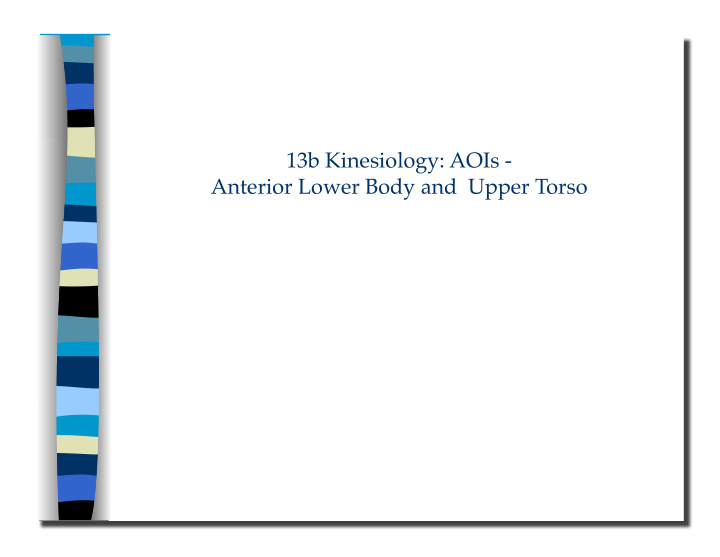



13b Kinesiology: AOIs - � Anterior Lower Body and Upper Torso
13b Kinesiology: AOIs - � Anterior Lower Body and Upper Torso � 10 minutes � Break Announce the return time and write it on the board. � 5 minutes � Attendance Also project the “Class Reminders” slide. � 30 minutes � 13b Kinesiology Quiz � 20 minutes � Cadaver Video: Acland’s DVD Atlas of Human Anatomy � 10 minutes � Break Announce the return time and write it on the board. � 55 minutes � Anatomy in Clay � 10 minutes � Break Announce the return time and write it on the board. � 60 minutes � Palpation � 10 minutes � Break down, clean up, and circle up � 3h 30m � � Total Class Time �
13b Kinesiology: AOIs - � Anterior Lower Body and Upper Torso �
13b Kinesiology Quiz Grading your Quiz � If an answer is correct, DO NOTHING � � If an answer is incorrect � � – Put an X through the incorrect answer � – Write the correct answer to the left in the margin � Example: � � C � _ B_ 1. What is anatomy? � � � A. Study of fishing � � � B. Study of the functions of the body � � � C. Study of the structures of the body � � � D. None of the options �
13b Kinesiology Quiz Scoring your Quiz � � BASE GRADE: count the number of WRONG answers (questions 1-20) and circle that number on the front page of the quiz � � EXTRA CREDIT: count the number of CORRECT extra credit points earned (questions 21-25) and write that number on the line to the right. � � FINAL GRADE: add the base score to the extra credit points and write the final grade on the line to the right �
8 a Written Exam Prep Quiz August 2014 8/14/14 Christopher Fritel N a m e Group Date 8:25 8:35 10 minutes Start time ______________ End time _____________ Total test time ___ _________ Number of wrong answers Grade Extra Credit Final Grade 0 100% + __________ = __________% 1 95% + __________ = __________% 2 90% + __________ = __________% 3 85% + __________ = __________% 4 80% + __________ = __________% 3 78 5 75% + __________ = __________% 6 70% + __________ = __________% 7 65% + __________ = __________% 8 60% + __________ = __________% 9 55% + __________ = __________% 10 50% + __________ = __________% 11 45% + __________ = __________% 12 40% + __________ = __________% 13 35% + __________ = __________% 14 30% + __________ = __________% 15 25% + __________ = __________% 16 20% + __________ = __________% 17 15% + __________ = __________% 18 10% + __________ = __________% 19 5% + __________ = __________% 20 0% + __________ = __________ %
Cadaver Video DVD 2, Part 3, Chapters 28-29: Tibialis Anterior � � DVD 2, Part 3, Chapters 41-45: Peroneals (longus, brevis, and tertius) � � DVD 2, Part 2, Chapters 27-31: Quads � � DVD 2, Part 1, Chapter 50: Quads � � DVD 3, Part 3, Chapters 29-43: Abdominals � � DVD 1, Part 1, Chapters 44-46: Pectoralis Major � �
Anatomy in Clay Write this list on the board and turn the projector off for now: � – Tibialis anterior � – Peroneus longus � – Peroneus brevis � – Rectus femoris � – Vastus lateralis � – Vastus medialis � – Vastus intermedius � – Rectus abdominis � – Pectoralis major �
Palpation Set Up by the Students � Students form groups of 3. � � Each group sets up a table and gets 1 face cradle, 1 bolster, and 2 chairs. � � Receivers must remain clothed. � � There will be no need of sheets except for a face cradle cover. � � Demo and Practice � All of the students come to a central table to watch a brief demonstration of how � to palpate one of the focus muscles: � – List and identify the bony landmarks, especially origins and insertions. � – List and identify the muscle bellies and tendons. � – List and explain the actions. � – Demo how to palpate the muscle while simultaneously offer resistance to the action, “Contract, relax. Contract, relax.” � – The students go back to their table to practice the palpation. � – 2 students palpate the third student collaboratively. � – The instructor and assistant circulate to offer guidance and touch comparisons: � This process repeats for each muscle that will be palpated. � � Once all the focus muscles have been palpated on the first student, repeat the � process so that each student will palpate twice and be palpated once. �
A � O � I � � Anteromedial View
A � O � I � � Anteromedial View
A � O � I � � Anteromedial View
Quadriceps Femoris � � Trail Guide, Page 306 The quads primarily extend the tibiofemoral joint. � Rectus femoris is cylindrical, superficial, and the only quadricep muscle that also crosses the . � Vastus intermedius � is deep to the rectus femoris. � Vastus medialis forms a teardrop shape at the distal portion of the medial thigh. � Vastus lateralis is the sole muscle of the lateral thigh. � � Anterior View � Anterior View When do you use trapezius? �
A � O � I � � Anterior View
A � � Anterior View O � I �
13b Kinesiology: AOIs - Posterior Lower Body
Recommend
More recommend